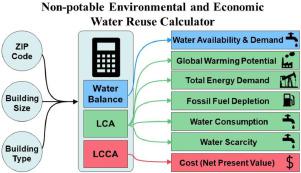Water Research ( IF 11.4 ) Pub Date : 2020-11-13 , DOI: 10.1016/j.watres.2020.116635 Sam Arden 1 , Ben Morelli 1 , Sarah Cashman 1 , Xin Cissy Ma 2 , Michael Jahne 2 , Jay Garland 2

|
Onsite non-potable reuse (NPR) is a way for buildings to conserve water using onsite sources for uses like toilet flushing, laundry and irrigation. Although early case study results are promising, aspects like system suitability, cost and environmental performance remain difficult to quantify and compare across broad geographic contexts and variable system configurations. In this study, we evaluate four NPR system types – rainwater harvesting (RWH), air-conditioning condensate harvesting (ACH), and source-separated graywater and mixed wastewater membrane bioreactors (GWMBR, WWMBR) – in terms of their ability to satisfy onsite non-potable demand, their environmental impacts and their economic cost. As part of the analysis, we developed the Non-potable Environmental and Economic Water Reuse Calculator (NEWR), a publicly available U.S. EPA web application that allows users to generate planning-level estimates of system cost and environmental performance using location and basic building characteristics as inputs. By running NEWR for a range of scenarios, we find that, across the U.S., rainfall and air-conditioner condensate are only able to satisfy a fraction of the non-potable demand typical of large buildings even under favorable climate conditions. Environmental impacts of RWH and ACH systems depend on local climate and were comparable to the ones of MBR systems where annual rainfall exceeds approximately 10 in/yr or annual condensate potential exceeds approximately 3 gal/cfm. MBR systems can meet all non-potable demands but their environmental impacts depend more on the composition of the local energy grid, owing to their greater reliance on electricity inputs. Incorporation of thermal recovery to offset building hot water heating requirements amplifies the influence of the local grid mix on environmental impacts, with mixed results depending on grid composition and whether thermal recovery offsets natural gas or electricity consumption. Additional environmental benefits are realized when NPR systems are implemented in water scarce regions with diverse topography and regions relying on groundwater sources, which increases the benefits of reducing reliance on centralized drinking water services. In terms of cost, WWMBRs were found to have the lowest cost under the largest range of building characteristics and locations, achieving cost parity with local drinking water rates when those rates were more than $7 per 1000 gallons, which occurred in 19% of surveyed cities.
中文翻译:

大型建筑的现场非饮用水再利用:环境和经济适宜性作为建筑特征和位置的函数
现场非饮用水再利用 (NPR) 是建筑物利用现场水源进行节约用水的一种方式,例如冲厕所、洗衣和灌溉。尽管早期的案例研究结果很有希望,但系统适用性、成本和环境绩效等方面仍然难以在广泛的地理环境和可变的系统配置中进行量化和比较。在本研究中,我们评估了四种 NPR 系统类型——雨水收集 (RWH)、空调冷凝水收集 (ACH) 以及源头分离的灰水和混合废水膜生物反应器(GWMBR、WWMBR)——满足现场需求的能力非饮用水需求、其环境影响及其经济成本。作为分析的一部分,我们开发了非饮用水环境和经济水再利用计算器 (NEWR),这是一个公开可用的美国 EPA Web 应用程序,允许用户使用位置和基本建筑特征生成系统成本和环境绩效的规划级估算作为输入。通过针对一系列场景运行 NEWR,我们发现,在美国各地,即使在有利的气候条件下,降雨和空调冷凝水也只能满足大型建筑典型的非饮用水需求的一小部分。 RWH 和 ACH 系统的环境影响取决于当地气候,与年降雨量超过约 10 英寸/年或年冷凝水潜力超过约 3 加仑/cfm 的 MBR 系统相当。 MBR 系统可以满足所有非饮用水需求,但其环境影响更多地取决于当地能源网的组成,因为它们对电力输入的依赖更大。 采用热回收来抵消建筑热水供暖需求会放大当地电网组合对环境影响的影响,结果好坏参半,具体取决于电网构成以及热回收是否抵消天然气或电力消耗。当在地形多样的缺水地区和依赖地下水源的地区实施 NPR 系统时,可以实现额外的环境效益,从而增加减少对集中式饮用水服务依赖的效益。就成本而言,WWMBR 在最大范围的建筑特征和位置下具有最低的成本,当当地饮用水费率超过每 1000 加仑 7 美元时,其成本与当地饮用水费率持平(19% 的受访城市出现这种情况) 。











































 京公网安备 11010802027423号
京公网安备 11010802027423号